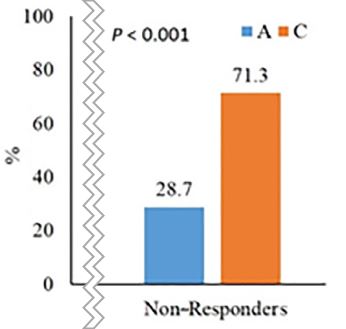Poor Vitamin D response 4X more likely if poor Vitamin D binding proteins
Efficacy of vitamin D supplementation according to vitamin D-binding protein polymorphisms.
Nutrition. 2019 Feb 19;63-64:148-154. doi: 10.1016/j.nut.2019.02.003.
Al-Daghri NM1, Mohammed AK2, Bukhari I3, Rikli M4, Abdi S5, Ansari MGA5, Sabico S5, Hussain SD5, Alenad A6, Al-Saleh Y4, Alokail MS6.
📄 Download the PDF from VitaminDWiki
RS4588


OBJECTIVES: The aim of this study was to determine the influence of vitamin D-binding protein (DBP) gene polymorphisms in vitamin D metabolites before and after vitamin D supplementation.
METHODS: In all, 234 participants (126 women; 108 men) with vitamin D deficiency [25(OH)D <50 nmol/L] were given 50 000 IU of vitamin D supplements for 8 wk followed by daily maintenance of 1000 IU for 4 mo. Two single-nucleotide polymorphisms (rs4588 and rs7041) in DBP coding gene were assessed.
RESULTS: Baseline 25(OH)D was significantly in higher in participants with homozygous major genotype of rs7041 than other genotypes (P = 0.02). Post supplementation 25(OH)D was significantly higher in participants with homozygous major genotypes of either rs4588 and rs7041 than other genotypes (P < 0.001).
Participants with the minor allele of either rs4588 or rs7041 were 2.9 (1.9-4.5) times and 3.7 (2.1-6.6) times, respectively, more likely to be non-responders (post supplementation 25 OHD <50 nmol/L) than those homozygous for the major allele at these locations (P < 0.001).
Furthermore, participants with homozygous minor and heterozygous genotype of rs7041 were 6.2 and 4.2 times more likely to be non-responders than those with the homozygous major genotype (P < 0.001) even after adjustments for age, sex, body mass index, baseline 25(OH)D concentration, and other alleles.
Participants with homozygous minor and heterozygous genotypes of rs4588 were 4.1 and 12.4 times more likely to be non-responders than those with homozygous major genotypes. These significant risks, however, were lost after adjustment.
CONCLUSIONS: rs7041 and rs4588 variants of the DBP gene are associated with variations in 25(OH)D levels and efficacy of response to vitamin D supplementation in Saudi Arabian adults.
